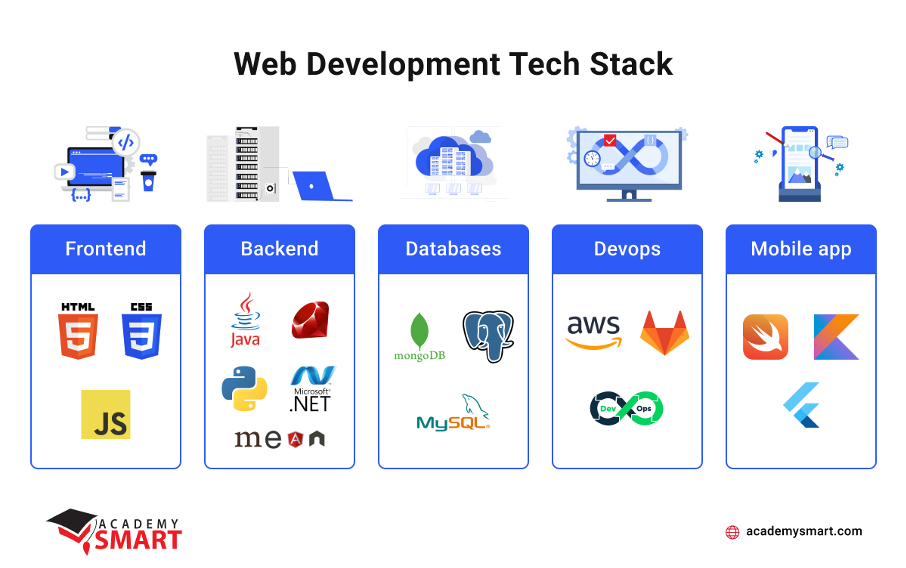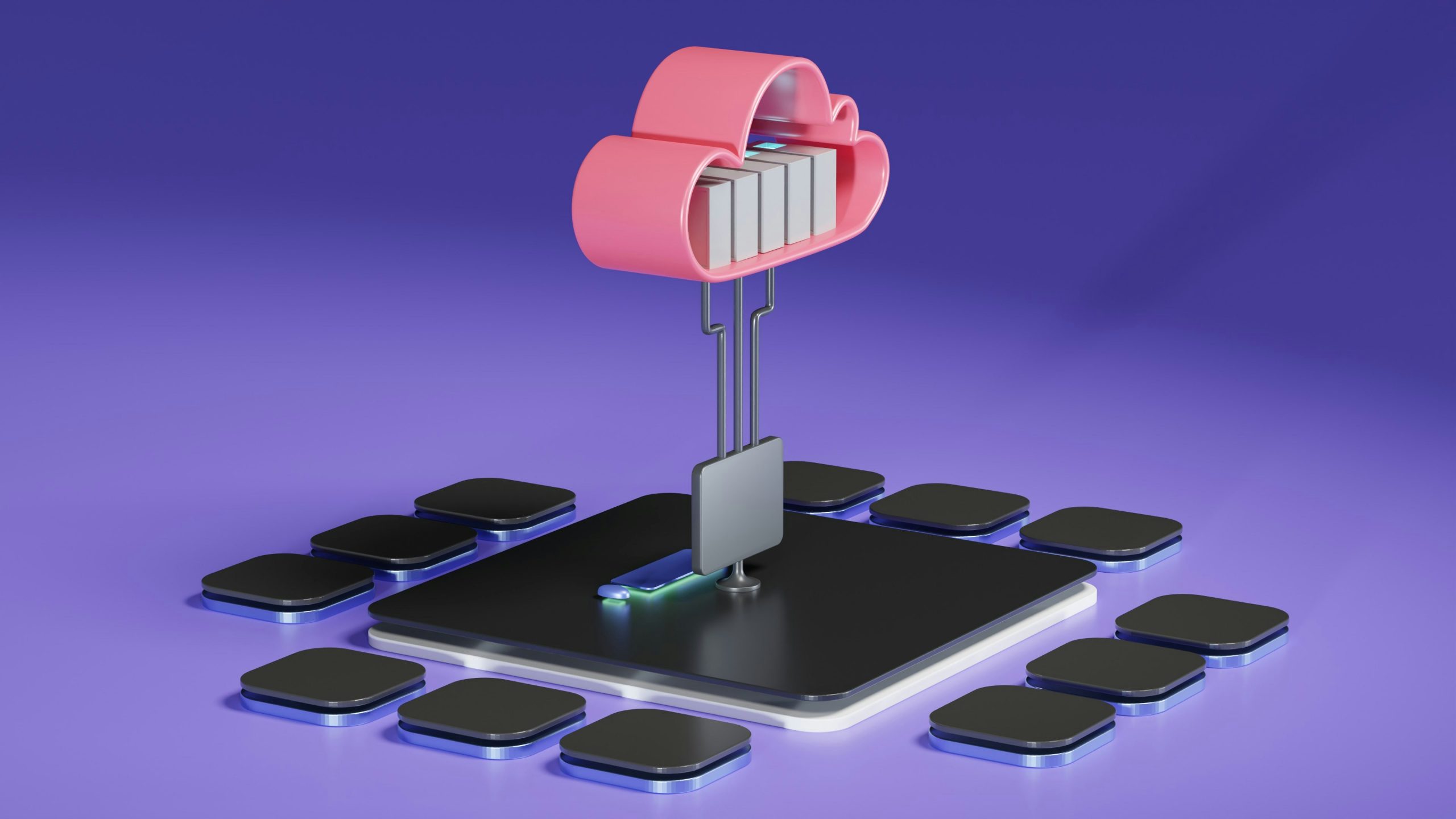A tech stack is a set of technologies used to build a digital product. It comprises of programming languages, frameworks, libraries, databases, and other software tools and technologies stacked together for use by development teams.
First, let’s review all the different tech stacks that exist and then how to choose the right one for your team.
1. What’s inside a tech stack ?
First, you should know that software tech stacks are divided into two parts: frontend and backend.
Developers use frontend tools to build the application’s customer-facing parts – basically, everything that you see on screen, whereas back-end tools are on the server side and pretty much do the heavy lifting so the app can work.
a. Front-End ( Client-side)
Here are the Technologies responsible for what users see:
HTML – Hyper Text Markup Language : responsible for the structure and content meaning all the text that you see online
CSS – Cascade Style Sheets : responsible for the styling: color, fonts, layouts.
JavaScript – allows to make a webpage interactive and dynamic. They come with frameworks and libraries which are essentially pre-written code that developers can utilize to speed up the creation process.The most popular ones are React, Vue.js, Angular, etc.
Mobile: Swift (iOS), Kotlin (Android), Flutter
b. Back-End (Server Side)
This is the submerged part of the iceberg and the most complex part. It handles data processing, business logic, and database interaction.
- Programming languages: Node.js, Python, Java, Ruby, PHP, etc.
- Frameworks : Express (Node), Django (Python), Spring (Java), etc.
- Databases :
- Relational (SQL): PostgreSQL, MySQL
- Non-Relational (NoSQL): MongoDB, Redis
c. Web Servers & Operating Systems
As we’ve seen, the choice of hosting has a greater impact on scaling than the choice of the stack. For cloud hosting, you have several choices : AWS, Google Cloud, Azure,..
And Operating Systems are the underlying programs that host and manage all other applications. These include Linux and Microsoft.

Source: Academy Smart
While you can combine any of these technologies to build a custom solution for your company, developers often turn to several common stacks. These include LAMP, MERN, and MEAN.
2. LAMP, MEAN and MERN
Most development teams don’t build a tech stack from scratch. Instead, they use one of the following popular stacks as a foundation for their product and add other technologies.
a. LAMP
The LAMP STACK is a popular tech stack for software development. It consists of four main components: Linux, Apache, MySQL, and PHP.
It is known for its simplicity, adaptability, and low cost perfect for small to medium-size projects.
Moreover, LAMP is completely open-source. It’s also very customizable. You can change operating systems (like trading Windows for Linux, making it WAMP) or programming languages without affecting much.
For example, Wodrpress that powers 40% of all websites operates on the LAMP stack.
b. MEAN
Mean Stack is another popular technology stack for software development. It is a free and open-source tech stack, and its components include MongoDB, Express.js, AngularJS, and Node.js. This stack is known for its versatility and flexibility, making it an excellent choice for developing dynamic and real-time applications.
One of the key advantages of the MEAN stack is its ability to use JavaScript on both the client and server sides, which reduces the need for developers to switch between different programming languages.
MEAN stack is an excellent choice for developing real-time web apps like chat apps, gaming apps, and collaborative tools.
For example, YouTube incorporates the MEAN stack for specific features to enhance real-time user engagement and video interactions.
c. MERN
MERN is almost identical to MEAN, except it uses React.js instead of Angular.
MERN stack is an excellent choice for developing modern and dynamic web applications due to combining these four technologies.
MERN stack applications are highly scalable, performant, and easy to maintain. Additionally, a large and active community of developers and users contribute to the stack’s growth and development, making it a reliable and future-proof choice for web development.
For example, Netflix uses the MERN stack for its front-end user interface to deliver high-performance streaming experiences
3. How to choose the right stack
The more aligned your tech stack is with you team and goals, the better it is.
a. Learn about tech stacks
Understanding the strengths and weaknesses of each will help you make more informed decisions about the future of your product, including how to scale it.
It will also help you to have a better communication with your technical team. Developers tend to get frustrated when product managers don’t understand what they are doing and how long it’s gonna take them to build the app.
This will prevent miscommunication, unrealistic timelines, and missed deadlines.
b. Project requirements
The specific functionality and features your project requires will often dictate the choice of technology.
Depending on the complexity of the project, some programming languages and frameworks are better suited for handling performance and scalability demands.
For example, choosing a monolithic architecture ( if not familiar with this term, you can read all about it here ) and PHP code are more adapted to a simple project.
c. Market trends
Staying ahead of the curve by embracing a trending technology can give your project a competitive edge. This can translate into innovative features, an enhanced user experience, or improved security.
What’s more, retaining talent and the availability of third-party integrations and libraries.
is far more easier when the technology is popular and in high-demand.
d. Time & Budget
As always, realizing a great product takes time and money. If you are tight deadline for example, working with MEAN/MERN can be a good choice.
Common costs include:
- Hosting and servers
- Licensing fees
- Developer salaries
- Maintenance
To decrease costs as much as possible, you can choose open-source versions
e. Team Expertise
Working with the technologies that your team is always familiar with seems logical. However, when going for new trending technologies or other, take into account the learning curve as well as the presence of ample documentation and community support
f. Security & Compliance
Some apps need more security than others, as for example fintech apps.
Where security is paramount, you’ll want to use a solution that is robust enough to withstand cyberattacks and data breaches.
